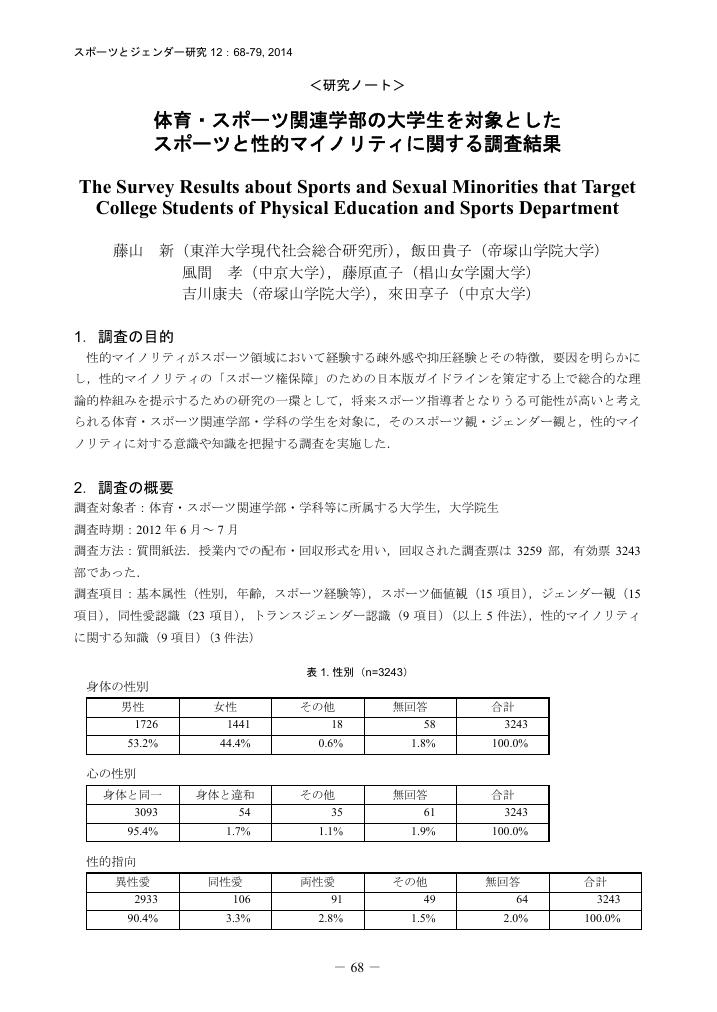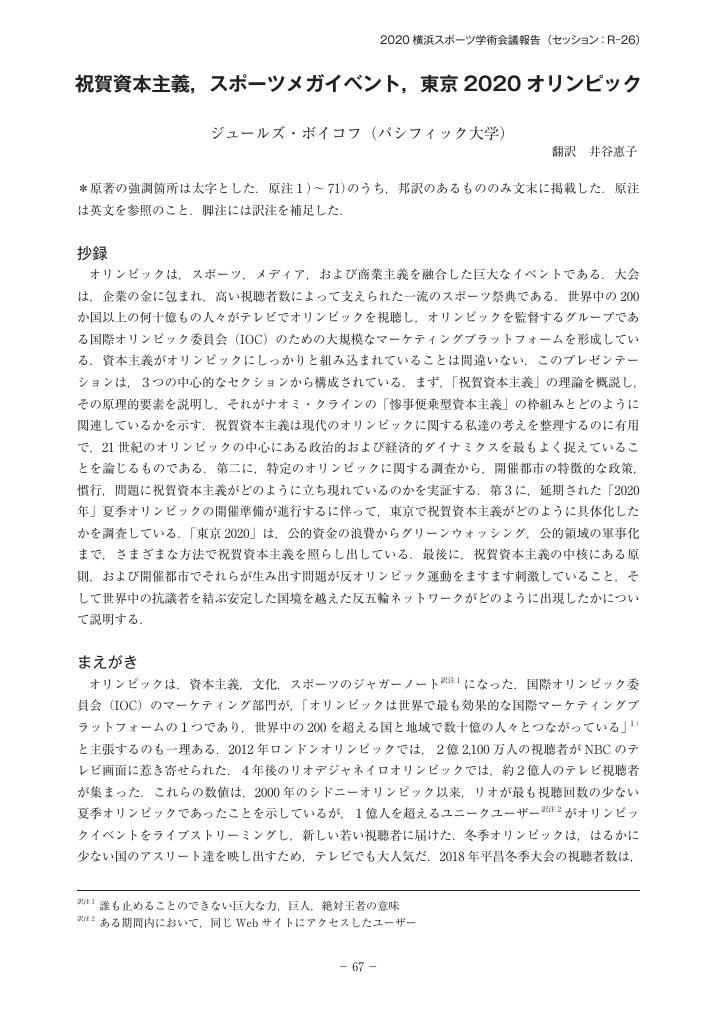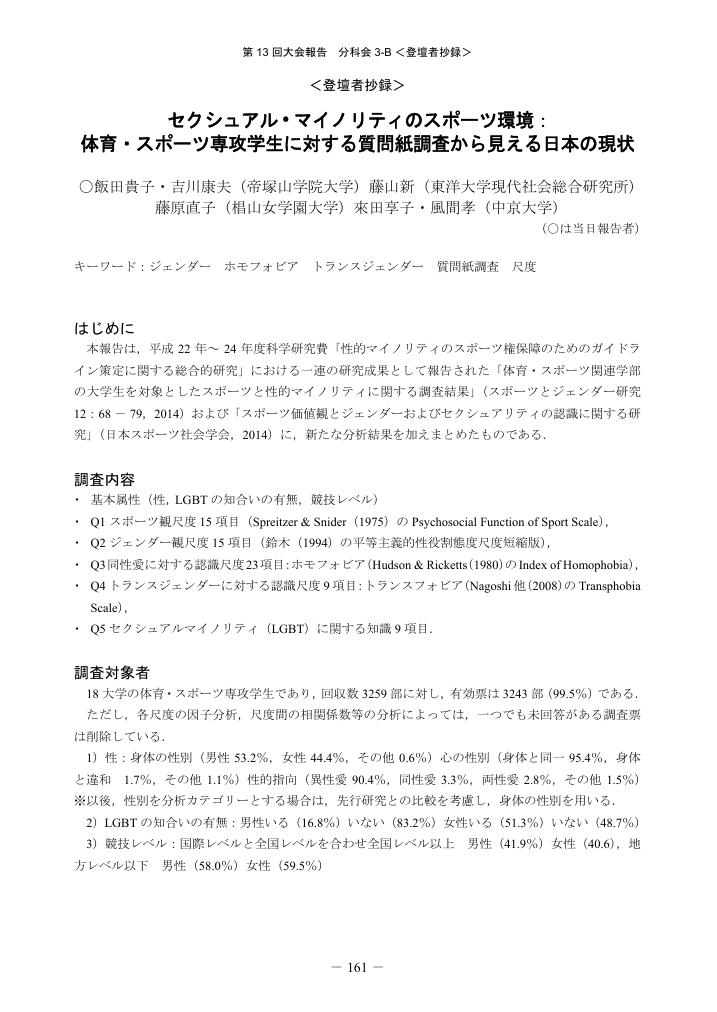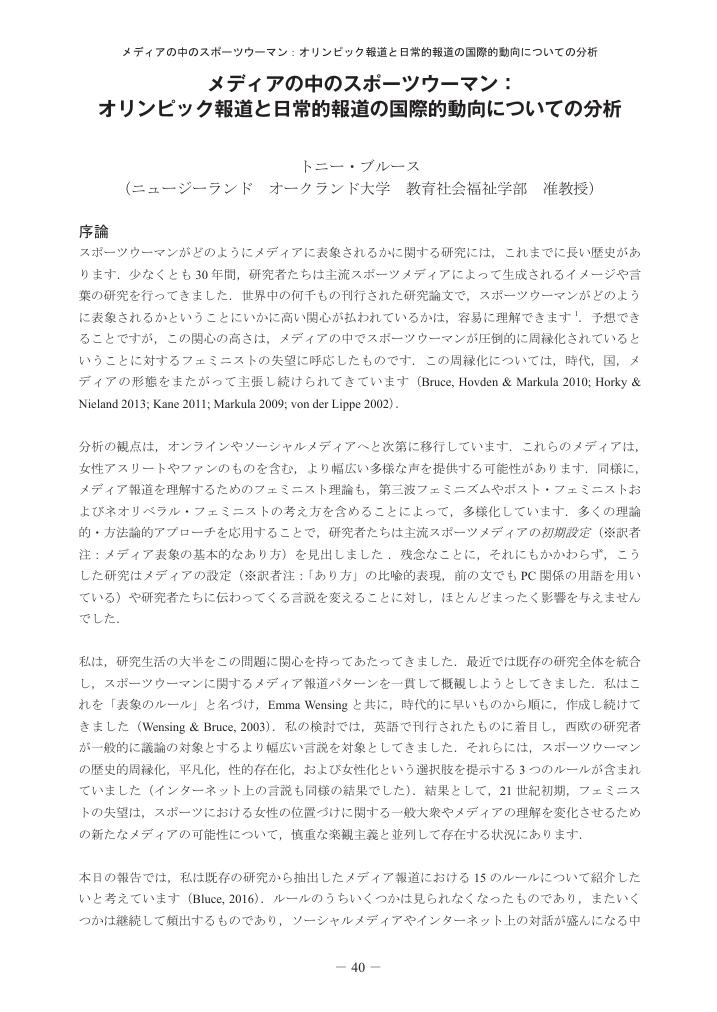7 0 0 0 OA 「男らしさ」と横綱柏戸の表象
- 著者
- 川野 佐江子
- 出版者
- 日本スポーツとジェンダー学会
- 雑誌
- スポーツとジェンダー研究 (ISSN:13482157)
- 巻号頁・発行日
- vol.14, pp.33-42, 2016 (Released:2017-04-25)
- 参考文献数
- 7
- 著者
- 建石 真公子
- 出版者
- 日本スポーツとジェンダー学会
- 雑誌
- スポーツとジェンダー研究 (ISSN:13482157)
- 巻号頁・発行日
- vol.15, pp.98-106, 2017 (Released:2017-12-10)
- 参考文献数
- 4
5 0 0 0 OA 運動・スポーツ種目の実施率の男女差について 実施率の時系列変化に着目して
- 著者
- 大勝 志津穂
- 出版者
- 日本スポーツとジェンダー学会
- 雑誌
- スポーツとジェンダー研究 (ISSN:13482157)
- 巻号頁・発行日
- vol.13, pp.56-65, 2015 (Released:2017-04-14)
- 参考文献数
- 19
4 0 0 0 OA 体育・スポーツ関連学部の大学生を対象としたスポーツと性的マイノリティに関する調査結果
- 著者
- 藤山 新 飯田 貴子 風間 孝 藤原 直子 吉川 康夫 來田 享子
- 出版者
- 日本スポーツとジェンダー学会
- 雑誌
- スポーツとジェンダー研究 (ISSN:13482157)
- 巻号頁・発行日
- vol.12, pp.68-79, 2014 (Released:2017-04-28)
- 参考文献数
- 12
- 被引用文献数
- 8
- 著者
- 藤山 新 飯田 貴子 吉川 康夫 井谷 聡子 風間 孝 來田 享子 佐野 信子 藤原 直子 松田 恵示
- 出版者
- 日本スポーツとジェンダー学会
- 雑誌
- スポーツとジェンダー研究 (ISSN:13482157)
- 巻号頁・発行日
- vol.8, pp.63-70, 2010 (Released:2021-01-01)
- 参考文献数
- 7
- 著者
- 三上 純
- 出版者
- 日本スポーツとジェンダー学会
- 雑誌
- スポーツとジェンダー研究 (ISSN:13482157)
- 巻号頁・発行日
- vol.18, pp.20-34, 2020 (Released:2020-09-30)
- 参考文献数
- 30
The purpose of this study was to investigate how homophobia is constructed in school physical education. Semi-structured interviews were conducted for 9 students who majored in physical education at A University of Education, and 5 students, three “sexual majority women” (cis-gendered, heterosexual) and two “sexual majority men” (cis-gendered, heterosexual), were selected for the analysis. The contents of interviews were about experiences what they had seen or heard discriminating words and actions in respect to sexuality. The result showed that heterosexism is accepted by getting information through media and school life, and that the consciousness is strengthened through “joke about sexuality” in school life in general. It was assumed that the “joke about sexuality” performed by male athletes inside of school-based extracurricular sports clubs is a tool to feel their “status as 'men'” and to “bond” with other than the targeted person. In addition, it was considered that the coaches actively use “joke about sexuality” with the clear intention of “helping to smooth communication” and “constructing normative masculinity”. Furthermore, it was shown that misogyny is also constructed in school-based extracurricular sports clubs by prohibiting romantic love only for female athletes. It was concluded that homophobia and misogyny are artfully created in school-based extracurricular sports clubs, and that homosociality is constructed including coaches in some cases. In this culture, students and athletes are expected that they learn the essentiality of homophobia in sports instruction and become teachers who convey it to the next generation through the mechanism of “occupational socialization into physical education teachers”. In the future research, it will be necessary to investigate in more detail how homophobia and misogyny appear in the two relationships between athletes each other, and, athletes and coaches.
3 0 0 0 OA 祝賀資本主義,スポーツメガイベント,東京2020 オリンピック
- 著者
- ボイコフ ジュールズ 井谷 惠子
- 出版者
- 日本スポーツとジェンダー学会
- 雑誌
- スポーツとジェンダー研究 (ISSN:13482157)
- 巻号頁・発行日
- vol.19, pp.67-79, 2021 (Released:2021-10-09)
- 参考文献数
- 4
- 著者
- Symons Caroline Hemphill Dennis 藤原 直子
- 出版者
- 日本スポーツとジェンダー学会
- 雑誌
- スポーツとジェンダー研究 (ISSN:13482157)
- 巻号頁・発行日
- vol.7, pp.52-70, 2009-03-20
- 著者
- 関 めぐみ
- 出版者
- 日本スポーツとジェンダー学会
- 雑誌
- スポーツとジェンダー研究 (ISSN:13482157)
- 巻号頁・発行日
- vol.14, pp.102-104, 2016 (Released:2017-04-25)
- 参考文献数
- 11
3 0 0 0 OA スポーツイベントと資本主義
- 著者
- 内海 和雄
- 出版者
- 日本スポーツとジェンダー学会
- 雑誌
- スポーツとジェンダー研究 (ISSN:13482157)
- 巻号頁・発行日
- vol.14, pp.86-101, 2016 (Released:2017-04-25)
- 参考文献数
- 20
‘A sport event’ is an expression which embraces a sport meeting and surrounding social phenomenon. A sport event here is confined as a mega sport event in contemporary capitalist society. Researches are required to clarify the merits and the demerits of the mega sport events. In the first half of this manuscript, “the social history and sport event” will be discussed. A primitive society was “the birth age of sports”, because sports were born as training for hunting. Sports were equally enjoyed by all people of the society. Then, the ancient slavery age, especially ancient Greece, emerged. As typically seen to ancient Olympics, the age was “a birth age of sport events”. feudalism society was dominated by religions. Since religions had a common belief that “Spirit dominates over body”, three body demands, exercise, sex and appetite, were very important subjects of religious training. Therefore, sport events disappeared from the medieval times of Europe. However, capitalist society required new movement cultures, such as sports (Britain), gymnastics (Sweden, Germany) and martial art (Japan) etc. And sport events were re-born in capitalist society. In the second half of this manuscript, “capitalism and sport events” will be discussed. Especially, the Olympics as a representative of mega sport events will be analyzed from the financial viewpoint and historically. The Olympics developed its gigantism and authority from the 1970s, with combining the global strategy of multinational corporations and the infrastructure building of Olympics host cities. The maladies (the sacrifice of the social welfare, environmental destruction etc.) became very severe. IOC and the Olympics have been pressured to make a sustainable mega sport event.
- 著者
- 來田 享子
- 出版者
- 日本スポーツとジェンダー学会
- 雑誌
- スポーツとジェンダー研究 (ISSN:13482157)
- 巻号頁・発行日
- vol.14, pp.136-138, 2016 (Released:2017-04-25)
- 被引用文献数
- 1
3 0 0 0 OA 1920-30年代の少女向け雑誌における「スポーツ少女」の表象とジェンダー規範
- 著者
- 小石原 美保
- 出版者
- 日本スポーツとジェンダー学会
- 雑誌
- スポーツとジェンダー研究 (ISSN:13482157)
- 巻号頁・発行日
- vol.12, pp.4-18, 2014 (Released:2017-04-28)
- 参考文献数
- 10
In the 1920s, sports were recognized as modern culture and rapidly became popular among female students through school extracurricular activities. Representations of sporting females began to appear in the monthly girls' magazines of this era as protagonists of sports-related fiction or real female athletes who took part in school matches or international athletic meets in non-fiction articles and journalistic reports with photos. The purpose of this study is to examine some representations and gender norms of “Sporting girls” by focusing on descriptions and visual images from “Shoujo Kurabu”, which was one of the most popular girls' magazines during the 1920s and 1930s. The results of this study are summarized as follows: 1. When “Shoujo Kurabu” was published starting in 1923, the sports boom among female students had already started, so we can see various reading material and visual images concerning sports appeared in the magazine from an early time. 2. (1) Visual images of female athletic bodies on front covers of “Shoujo Kurabu” reflect the developing process of typical representations of “sporting girls” in the initial stage of female sports participation. (2) From the representations of “sporting girls” on photo pages in the June issue of 1934, we find that society expected female athletic bodies to adhere to the social norms of traditional femininity including modesty and restraint when engaging in sports. (3) From readings about round-table talk discussions with female student athletes in the May issue of 1935, we can find that the traditional gender norms were rewritten by males, applying a sporting spirit that encourages female students to have high morals including diligence as well as decency and politeness in their behavior. The magazine seems to have contributed to the construction, promotion and cultivation of a new gender norm of the “sporting girl”.
3 0 0 0 OA 女性アスリートの痛みをめぐるエスノグラフィー
- 著者
- 申 恩真
- 出版者
- 日本スポーツとジェンダー学会
- 雑誌
- スポーツとジェンダー研究 (ISSN:13482157)
- 巻号頁・発行日
- vol.16, pp.6-19, 2018 (Released:2018-12-29)
- 参考文献数
- 24
The following research aims to discuss an issue that has been thought to belong within the "private" sphere - menstruation of female athletes. The research tackles menstruation beyond the realm of an individual's own physical experience, and extend the understanding of the issue in relation to an individual's "social" standing. Arthur Kleinman (Kleinman, 1988=1996) raised the point that the individual experience of suffering should be interpreted in terms of "illness", and underlined the need for taking the patient's local knowledge system, social relationships, and the respective social contexts and meanings into consideration when approaching such experience. Thus, the research adapted the perspective of "illness" as suggested by Kleinman and attempted to utilize this perspective in understanding the players of soccer team "K" and their meaning of suffering. Results revealed that players often experience three different types of menstrual suffering: 1) suffering expressible to anyone regardless of sex, 2) suffering expressible only to females, and 3) suffering expressible to no one. The research further indicated the different types of suffering each meant different levels of suffering. The third type of suffering, especially demonstrated that the social context bars females from expressing their suffering to other females, even though menstrual suffering is a common experience among females. In other words, the research revealed that menstruation is not only an issue between different sexes, but instead entailed double-sided concerns - different types of menstrual suffering and "perceived status" based on the player's characteristics. Therefore, this reseatch studies the difficulties female athletes face due to menstruation not in terms of a simple male/female dichotomy, but instead by analyzing those difficulties with respect to the social order and relationships within a team. With such understanding in mind, the research suggests the need to establish the topic, "Sociology of Suffering."
3 0 0 0 OA セクシュアル• マイノリティのスポーツ環境
- 著者
- 飯田 貴子 吉川 康夫 藤山 新 藤原 直子 來田 享子 風間 孝
- 出版者
- 日本スポーツとジェンダー学会
- 雑誌
- スポーツとジェンダー研究 (ISSN:13482157)
- 巻号頁・発行日
- vol.13, pp.161-163, 2015 (Released:2017-04-14)
- 著者
- 加藤 凌 三上 純
- 出版者
- 日本スポーツとジェンダー学会
- 雑誌
- スポーツとジェンダー研究 (ISSN:13482157)
- 巻号頁・発行日
- vol.21, pp.73-82, 2023 (Released:2023-12-21)
- 参考文献数
- 10
- 著者
- 掛水 通子
- 出版者
- 日本スポーツとジェンダー学会
- 雑誌
- スポーツとジェンダー研究 (ISSN:13482157)
- 巻号頁・発行日
- vol.4, pp.30-39, 2006 (Released:2020-09-30)
- 参考文献数
- 27
2 0 0 0 OA IOC ジェンダー平等再検討プロジェクト(2018) 「IOC ジェンダー平等報告書」
- 著者
- 新井 喜代加 石原 康平 大勝 志津穂 來田 享子
- 出版者
- 日本スポーツとジェンダー学会
- 雑誌
- スポーツとジェンダー研究 (ISSN:13482157)
- 巻号頁・発行日
- vol.18, pp.97-114, 2020 (Released:2020-09-30)
2 0 0 0 オリンピック,祝賀資本主義,活動家の応答
- 著者
- ボイコフ ジュールス 井谷 聡子
- 出版者
- 日本スポーツとジェンダー学会
- 雑誌
- スポーツとジェンダー研究 (ISSN:13482157)
- 巻号頁・発行日
- vol.16, pp.62-84, 2018
本発表は3部構成となっている.まず,第1部で「祝賀資本主義」理論についてその根本的主張を説明しながら紹介し,この理論がナオミ・クラインの「惨事便乗型資本主義」とどのように関係しているかを説明する.祝賀資本主義という概念は,近代オリンピックについての考え方を体系付けるのに有用であり,21世紀におけるオリンピック大会の根幹となる政治的,経済的力学をもっともよく捉えるものであると考える.第2に,特定のオリンピック大会の例を引きながら,祝賀資本主義が開催都市における特定の政策や実践の中でどのような形態をとるのかについて論証する.2010年のバンクーバー冬季オリンピック,2012年のロンドンオリンピック,2014年のソチ(ロシア)冬季オリンピック,そして2016年のリオデジャネイロオリンピックの例を見ながら,祝賀資本主義がいかに反オリンピック運動を刺激しうるかを示す.第3に,東京が2020年のオリンピック大会開催に向けて準備する中で,祝賀資本主義がどのように現れているのかを検証する.
2 0 0 0 OA メディアの中のスポーツウーマン オリンピック報道と日常的報道の国際的動向についての分析
- 著者
- ブルース トニー 前田 博子 井谷 聡子 來田 享子 田原 淳子
- 出版者
- 日本スポーツとジェンダー学会
- 雑誌
- スポーツとジェンダー研究 (ISSN:13482157)
- 巻号頁・発行日
- vol.15, pp.40-52, 2017 (Released:2017-12-10)
2 0 0 0 スポーツイベントと資本主義
- 著者
- 内海 和雄
- 出版者
- 日本スポーツとジェンダー学会
- 雑誌
- スポーツとジェンダー研究 (ISSN:13482157)
- 巻号頁・発行日
- vol.14, pp.86-101, 2016
'A sport event' is an expression which embraces a sport meeting and surrounding social phenomenon. A sport event here is confined as a mega sport event in contemporary capitalist society. Researches are required to clarify the merits and the demerits of the mega sport events. In the first half of this manuscript, "the social history and sport event" will be discussed. A primitive society was "the birth age of sports", because sports were born as training for hunting. Sports were equally enjoyed by all people of the society. Then, the ancient slavery age, especially ancient Greece, emerged. As typically seen to ancient Olympics, the age was "a birth age of sport events". feudalism society was dominated by religions. Since religions had a common belief that "Spirit dominates over body", three body demands, exercise, sex and appetite, were very important subjects of religious training. Therefore, sport events disappeared from the medieval times of Europe. However, capitalist society required new movement cultures, such as sports (Britain), gymnastics (Sweden, Germany) and martial art (Japan) etc. And sport events were re-born in capitalist society. In the second half of this manuscript, "capitalism and sport events" will be discussed. Especially, the Olympics as a representative of mega sport events will be analyzed from the financial viewpoint and historically. The Olympics developed its gigantism and authority from the 1970s, with combining the global strategy of multinational corporations and the infrastructure building of Olympics host cities. The maladies (the sacrifice of the social welfare, environmental destruction etc.) became very severe. IOC and the Olympics have been pressured to make a sustainable mega sport event.











